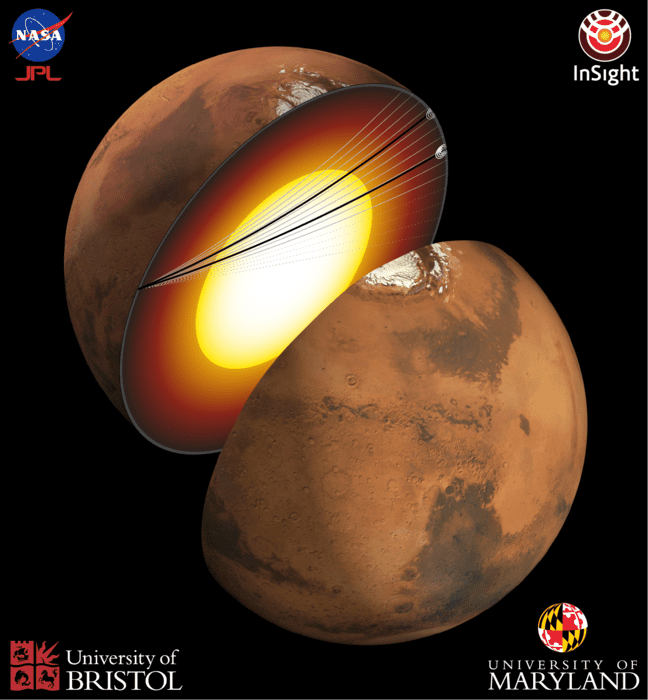
Though the InSight lander is now inactive, a new discovery using its data has shed light on what lies at the very heart of the Red Planet
Scientists have observed seismic waves traveling through Mars’ core for the first time. The research, published in the Proceedings of the National Academy of Sciences, was carried out by an international team of researchers from the University of Bristol (UB) and the University of Maryland (UMD). Using data from the NASA InSight lander, they could directly measure Mars’ core properties, confirming model predictions of the core’s composition.
The researchers found Mars has a completely liquid iron-alloy core with high percentages of sulfur and oxygen. This differs from Earth, which combines a liquid outer core and a solid inner core.
The high proportion of light elements in Mars’ innermost layer indicates that the planet’s core is less dense and more compressible than Earth’s. This difference in composition points to different formation conditions for the two planets.
Marsquakes reveal the guts of the Red Planet
The research involved tracking the progression of two distant seismic events on Mars and detecting waves that traveled through the planet’s core. Then, by comparing the time it took those waves to travel through Mars compared to waves that stayed in the mantle, and combining this information with other seismic and geophysical measurements, the team estimated the density and compressibility of the material the waves traveled through.
It’s a lot like a geological X-ray.
“In 1906, scientists first discovered the Earth’s core by observing how seismic waves from earthquakes were affected by traveling through it,” said UMD associate professor of geology Vedran Lekic, second author of the paper. “More than a hundred years later, we’re applying our knowledge of seismic waves to Mars. With InSight, we’re finally discovering what’s at the center of Mars and what makes Mars so similar yet distinct from Earth.”

The Martian seismic waves, the result of acoustic energy, revealed that the planet’s liquid core is also smaller and slightly denser than previous estimations. The research mission was initially scheduled to last for just over one Mars year, but NASA extended it after the InSight Mars lander successfully collected geophysical data, including signals of marsquakes, until the end of last year.
“The extra mission time certainly paid off,” said lead author Jessica Irving, UB senior lecturer in Earth Sciences. “We’ve made the very first observations of seismic waves traveling through the core of Mars. Two seismic signals, one from a very distant marsquake and one from a meteorite impact on the far side of the planet, have allowed us to probe the Martian core with seismic waves.”
The InSight lander deployed a broadband seismometer on the Martian surface in 2018, allowing for the detection of seismic events, including marsquakes and meteorite impacts.
“So-called ‘farside’ events, meaning those on the opposite side of the planet to InSight, are intrinsically harder to detect because a great deal of energy is lost or diverted away as waves travel through the planet,” Irving said. “We needed both luck and skill to find, and then use, these events. We detected no farside events in the first Martian year of operations. If the mission had ended then, this research couldn’t have happened. The sol 976 marsquake was the most distant event found during the mission. The second farside event, S1000a – the first event detected on day 1,000 of operations – was particularly useful because it turned out to be a meteorite impact which we heard all the way through the planet, so we knew where the seismic signals came from.”
As the team noted, the uniqueness of Earth’s core allows it to generate a magnetic field that protects us from solar winds and allows the planet to maintain water.
While Mars does not currently have a magnetic field, scientists hypothesize that there was once a magnetic shielding similar to Earth’s core-generated field due to traces of the magnetism lingering in Mars’ crust.
This might mean that Mars gradually evolved to its current conditions, changing from a planet with a potentially habitable environment into an incredibly hostile one. Conditions in the interior play a key role in this evolution, as might violent impacts.
The team’s findings have confirmed the accuracy of current modeling estimates that aim to unravel the layers hidden beneath a planet’s surface. For geophysicists, this discovery is paving the way for future expeditions to other celestial bodies, including planets like Venus and Mercury.



